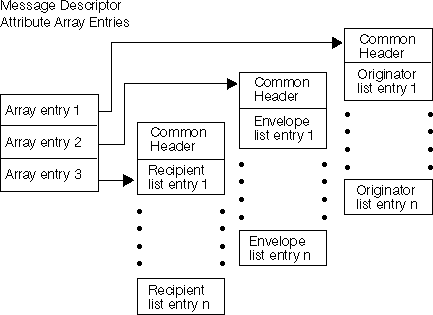
The mail server framework can be configured for up to 128 types in each type group. On each iSeries(TM) system, type configuration defines the list of the types that the system can process. The data that is passed to the Create Mail Message API must be in a type that is supported by the system.
A message type is associated with each recipient of the message and is used to tailor the processing of the message. Message types are usually assigned when address resolution takes place.
A message is the sum of all of the data in the message descriptors. These message descriptors are passed to the Create Mail Message (QzmfCrtMailMsg) API using the array of message descriptor attributes.
Figure 1 is an example of a message descriptor that has three descriptor lists being passed: 1) recipient list, 2) envelope list, and 3) originator list. The attachment list, original recipient list, reply-to address list, report-on address list, and report-to address list are optional descriptor lists.

If no errors are encountered during the creation of the mail message, the mail message identifier field contains the unique message identifier associated with the message. If a reserved mail message identifier had been passed, then the reserved mail message identifier is put in the mail message identifier parameter. If any errors are encountered during the creation process, an error message is generated and the mail message identifier returned is set to zeros.
All messages referred to in this section are issued synchronously.
All displacements are base 0 unless otherwise specified.
The AnyMail/400 Mail Server Framework Developer Guide, GG24-4449, focuses on the technical details needed to understand how the mail server framework works. It provides information about how to write programs that create MSF messages or act on MSF messages as MSF exit point programs.
| Top | Office APIs | APIs by category |